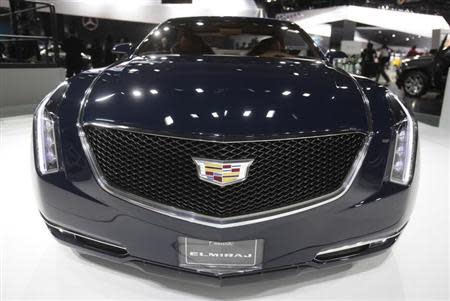GM to battle VW in China with $12 billion investment and new plants

BEIJING (Reuters) - U.S. car giant General Motors Corp (GM) plans to invest $12 billion in China from 2014 to 2017 and build more plants next year as it competes with aggressive rivals in the world's largest auto market. GM expects its China sales to expand 8-10 percent this year, in line with the overall growth of the Chinese market, where foreign firms, such as Volkswagen AG , and domestic players like SAIC Motor Corp <600104.SS> vie for more market share. "We are investing wisely and accelerating our vehicle development and manufacturing to keep pace with market demand. In total we are investing $12 billion between 2014 and 2017," Matt Tsien, president of GM China, said at the Auto China show in Beijing. GM plans to build five more plants in China next year, as part of its efforts to ramp up manufacturing capacity there by 65 percent by 2020, executives said on Sunday. Rival Volkswagen's early entry into China focused on rapidly-developing eastern provinces - now it plans to push into the west. VW's luxury division Audi which will target smaller megacities in central and western provinces to raise the number of dealerships by about half to 500 in the next three years, chief executive Rupert Stadler told Reuters. "That's where new business is emerging, where things get rolling," Stadler said at the Beijing show. "We don't need more dealers in Beijing and Shanghai." WESTERN CITIES China's auto market is set to expand 8-10 percent this year, slightly slowing from 2013 when it sold 21.98 million vehicles, up 13.9 percent from a year earlier. Vehicle density in China's smaller cities offer lucrative growth prospects. The average number of cars per 1,000 inhabitants in Yaan, a city of about 2 million population in central Sichuan province is 18, compared with 123 in first-tier coastal cities Shanghai and Guangzhou, according to VW's website. Parent VW was one of the first global automakers to launch production in China during the 1980s, is evolving its operations in the country by pushing west. "A large sales potential for passenger cars will develop there fairly quickly," Jochem Heizmann, head of VW's China operations told reporters. "That's one factor driving growth besides state-induced urbanization." VW, which last year opened factories in the western cities Chengdu and Urumqi, is counting on double-digit market growth to increase group deliveries to over 3.5 million this year, a record, from 3.27 million in 2013, CEO Martin Winterkorn said. China's auto market rose 13.9 percent to 21.98 million vehicles last year, compared with a 7.6 percent gain in the United States to 15.6 million. Wolfsburg-based VW, having eclipsed General Motors last year as the top-selling foreign brand in China, aims to consolidate its lead with aggressive spending. Its two joint venture partners, First Automotive Works <000800.SZ> and Shanghai Volkswagen, are planning to spend 18.2 billion euros through 2018, the year VW has pledged to take the global car-sales crown, on models, technologies and plants. GM's five new Chinese plants will be in Wuhan, Chongqing, Jinqiao and Shenyang. Four of those will be vehicle assembly plants, while the fifth one will be an engine plant in Shenyang. The Jinqiao plant will make its flagship Cadillac sedans. GM aims to sell 100,000 by 2015 in China, rising from roughly 50,000 last year, executives said. "Cadillac's growth is on the launch of new products. We launched the XTS, which allowed us to get to the 50,000 levels. This year, we will launch another significant product and next year, we will launch another," GM's Tsien said. (Reporting by Norihiko Shirouzu, Edward Taylor and Jan Schwartz in BEIJING; Writing by Lee Chyen Yee and Andreas Cremer, editing by William Hardy)

